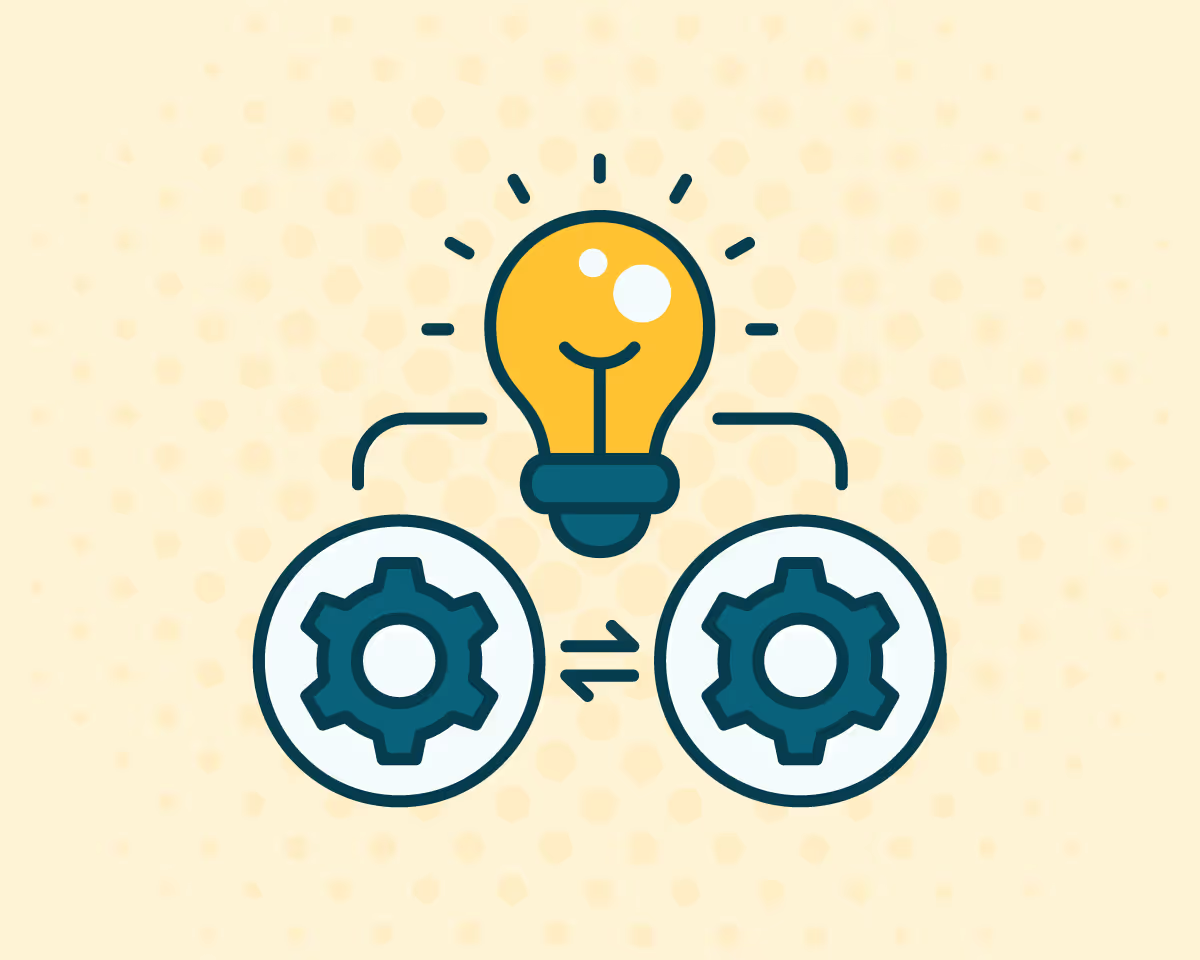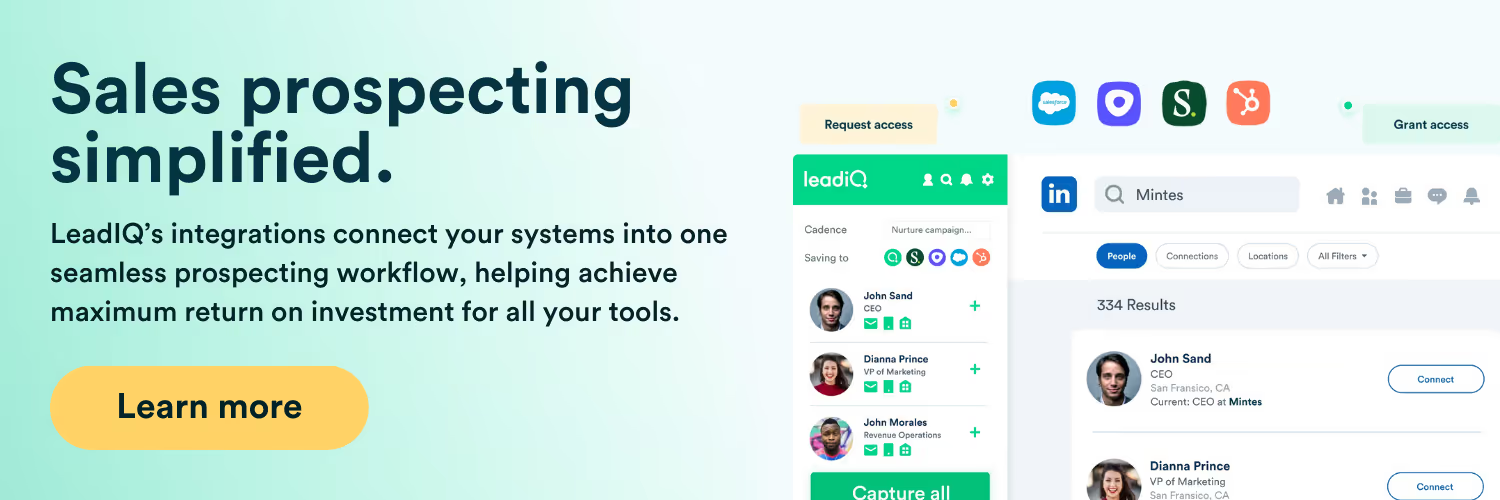Ready to create more pipeline?
Get a demo and discover why thousands of SDR and Sales teams trust LeadIQ to help them build pipeline confidently.



Ensure that tools in your sales tech stack are compatible and integrate smoothly with each other, reducing friction and enabling efficient workflows across the sales team.

Choose tools in your sales tech stackthat can scale with your business and anticipate future growth, avoiding the need for frequent replacements or upgrades as your company expands.

Invest in thorough training and encourage widespread adoption across the team to maximize the ROI of your sales tech stack, ensuring that everyone utilizes the tools effectively.
Get a demo and discover why thousands of SDR and Sales teams trust LeadIQ to help them build pipeline confidently.
In the fast-paced world of SaaS sales, teams need to do everything they can to work as efficiently as possible.
This is why it’s so important for sales teams to ensure their sales tech stack is modern, feature-rich, and fully integrated.
An integrated B2B sales tech stack delivers a ton of benefits, including:
Keep reading to learn about eight key tips for building a sales tech stack that will help you hit your numbers this quarter and beyond.
A sales tech stack is a collection of software tools that teams use to manage and automate their sales workflows. Typically, a B2B sales tech stack includes a customer relationship management (CRM) system, sales automation tools to streamline repetitive tasks, sales intelligence tools, sales engagement tools, sales analytics platforms, among many other solutions with features specifically tailored to sales teams. Think of the sales tech stack as any tool that the team will interact with in one way or another, to do their job in sales.
Very simply, a well-integrated sales tech stack enables teams to work together more efficiently, improve productivity, and drive better results across the entire sales cycle.
As you begin putting together the best sales tech stack for your team, follow these eight tips to increase the chances you build the perfect tool for the job.
Next, you need to define your objectives and prioritize solutions based on their potential impact on revenue, sales efficiency, and overall business goals. This entails identifying key performance indicators (KPIs) aligned with revenue growth, operational efficiency, and strategic objectives.
At this stage, consider leveraging SMART goals — goals that are specific, measurable, achievable, relevant, and timely — to ensure your objectives are clear and actionable and that you have a timeline in mind for when you hope to achieve them.
Once you’ve defined your objectives and goals, you can start designing your tech stack in a way that helps you achieve them.
Putting together an effective sales tech stack starts with thoroughly assessing your team’s needs and pain points. To do this, conduct interviews or surveys with key team members to identify specific challenges they face and areas they’d like to improve. It is rare to start with a blank slate unless you are the founder of a new company, so you will likely be inheriting an existing stack or pieces of one. Leverage your internal stakeholders to better understand what’s “working” and what’s not “working” to help prioritize your efforts.
Analyzing historical data can be helpful, too. By doing so, you can identify bottlenecks in the sales process and offer insights into where efficiencies might be gained.
Additionally, collaborating with stakeholders from various departments provides valuable insights into cross-functional requirements, ensuring the tech stack you ultimately end up with aligns with broader organizational goals. For example, the collaboration tool you choose will be used by all other teams, not just sales, so you need to plan accordingly. You will likely also find that new tools may not actually be needed, but better processes, usage, and enablement of existing tools must be attempted first.
By doing your due diligence up front, you lay the foundation that ensures your sales tech stack addresses specific challenges and ultimately helps your sales team accomplish its goals.
If the tools you use and implement do not play nicely with one another, you could end up spending more time trying to make them “work” together, than actually getting value out of them as a result. Integrations and collaboration between systems is critical.
To avoid learning the hard way that the solutions you’re considering aren’t compatible, create a detailed checklist of features and functionalities that meet the essential criteria your organization requires. This checklist ensures that the tools you select align with your organization’s needs and can seamlessly integrate with each other along with your existing systems.
Once you’ve put together a checklist, consult your IT experts or those with domain experience and/or those who will ultimately be responsible for implementing, to verify the decisions you are making will be compatible. Make sure to involve key team members in vendor demos to ensure that they’re on board with each solution.
By ensuring tools in your stack are compatible with each other, you can ensure a smooth implementation while increasing the chances your new tech stack lives up to your expectations.
At LeadIQ, we understand how important it is for the tools sellers use in their day-to-day lives to play nicely with each other, so we’ve built our platform in a way that ensures it integrates seamlessly with other popular sales solutions. Learn more about LeadIQ’s integrations.

You want to scale your company, and the tech stack you assemble needs to keep pace. There are certainly times when you will make decisions based on factors like budget, that may have a finite period of value, but your goal should always be to plan for the future when possible. If you believe a tool will have an expiration date, that’s fine but it is important to be aware of this in advance to avoid headaches down the road when time comes to make an upgrade or replacement.
As you begin searching for solutions, keep scalability top of mind and evaluate vendors based on their track record of supporting growing businesses. While you’re exploring your options, assess whether vendors have experience in accommodating increasing user bases, data volumes, and transaction volumes over time.
Additionally, organizations should consider solutions that offer flexible pricing models, allowing for adjustments as business needs evolve. While you can’t predict the future, you can forecast what future resource requirements might look like based on company growth and budget. Using those estimates, you can get a better idea of whether the solutions you deploy can accommodate growing demands without significant disruptions or cost implications.
Pricing inevitably changes. Do everything you can up front to ensure that the pricing structure you agree to will work for you now, throughout the term of your agreement, and beyond into phases of renewal and growth.
If your sales reps don’t know how to use the tools in your stack productively, you may not get the ROI you have in mind. As you begin rolling out your new stack, invest in training to ensure that your employees are familiar with each tool’s capabilities and understand why they’re being asked to change the way they work.
By developing customized training materials for your sales team, you can help them work more effectively when they’re in real-world circumstances. After you’ve created training materials, conduct workshops and training sessions so reps get hands-on experience with the new tools. Even better, include these materials in your new hire onboarding process to ensure rookies get up to speed quickly and the team stays aligned.
Since every employee will learn technology at a different pace, offer ongoing support and lend a helping hand to those who need it. Better yet, look for vendors that offer training resources of their own. Who better to teach the ins and outs of a platform than the team that makes it?
You might put together the best sales tech stack in the world. But if no one on your team is using it, you won’t get the results you’re hoping for.
In our experience, the main reason that teams don’t renew tools isn’t due to a lack of capabilities but a lack of adoption.
To avoid that fate, appoint internal champions and power users to become advocates across the team as you begin rolling out your stack. People are resistant to change; when their peers encourage them to use new tools and demonstrate how those tools are helping them accomplish more every day, it may be easier to get more folks on board.
While you’re at it, survey your team periodically to find out what they think of the new tools and what they might do differently if they had the final say. It’s an easy way to demonstrate that you’re listening and really want to help.
Getting the most out of your stack requires keeping everyone on the same page. To do this, develop policies to ensure consistent data quality, security, and compliance across the organization. This includes defining standards and procedures for how to use tools. For example, if you add LeadIQ to your stack, you should document rules about data collection, storage, and usage to maintain accuracy and integrity.
To ensure only authorized individuals can access important systems, implement role-based access controls, which reduce the risk of bad actors intercepting your data. Additionally, conduct regular audits of data practices and security measures to help identify any vulnerabilities or compliance issues and take immediate action if any are found.
No matter how good your team is doing, you can always improve. Define ownership within your org- if RevOps owns a system, who on the RevOps team or what team within the greater RevOps team owns each specific system? Without clear ownership, initiatives like measurement and analysis inevitably end up on the back burner.
Make sure each tool in your tech stack offers robust reporting capabilities, and encourage your team to utilize those features regularly. Set time aside to train your team on what the data means and how to interpret and act on it.
By creating a data-driven culture, you can use analytics to continuously fine-tune your strategies, getting better and better outcomes over time.
LeadIQ is an award-winning sales intelligence platform built to help teams accelerate pipeline and improve their outbound prospecting efforts.
Our solution plays well with others, with seamless integrations with tools your team uses every day, including Salesforce, HubSpot, Salesloft, Gong, Outreach, and Gmail.
To learn more about why LeadIQ is the perfect tool to add to your new sales tech stack, request a demo today. Better yet, take LeadIQ for a free test drive today.